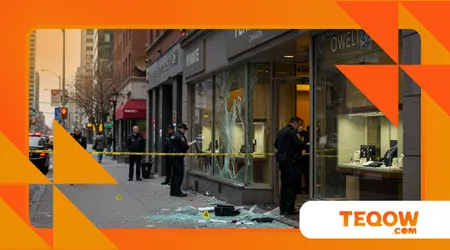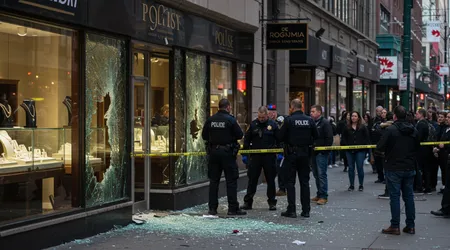Toronto Jewelry Store Robbed for Third Time, Sparking Calls for Greater Security

Toronto Jewelry Store Robbed for Third Time these chilling words have echoed through the Greater Toronto Area, igniting fear and frustration among business owners and residents alike.
On April 24, 2025, Harmony Jewellers in Grimsby, Ontario, fell victim to its third robbery in recent years, a brazen act captured on shocking security footage.
The incident, involving five masked suspects armed with weapons, has thrust the issue of retail crime into the spotlight, prompting urgent calls for enhanced security measures.
This isn’t just a story about one store; it’s a wake-up call for a city grappling with rising smash-and-grab heists.
Why are these crimes becoming so frequent, and what can Toronto do to protect its businesses?
Retail crime, particularly targeting jewelry stores, has surged in Toronto and the GTA, with businesses facing unprecedented challenges.
The emotional toll on owners, like those at Harmony Jewellers, is palpable fear for their safety, frustration with a seemingly lenient justice system, and dwindling faith in law enforcement’s ability to curb these incidents.
This article dives deep into the Toronto Jewelry Store Robbed for Third Time, exploring its ripple effects, the broader crime trends, and actionable solutions to fortify security.
From advanced technology to community-driven initiatives, we’ll unpack what’s at stake and how Toronto can reclaim its sense of safety.
The Alarming Reality of Repeat Robberies in Toronto
The Toronto Jewelry Store Robbed for Third Time at Harmony Jewellers wasn’t an isolated incident but part of a disturbing pattern.
On April 24, 2025, five suspects stormed the store at 11:25 a.m., wielding weapons and shattering display cases.
No one was seriously injured, but the psychological scars linger. Niagara Regional Police are investigating, yet the suspects remain at large, fueling public outrage.
This wasn’t Harmony’s first brush with crime. Previous robberies left the owners shaken, questioning their future in retail.
Across the GTA, jewelry stores are prime targets due to high-value inventory and quick resale potential.
A 2024 Retail Council of Canada report noted a 300% spike in smash-and-grab robberies in Ontario since 2020, with Toronto at the epicenter.
The audacity of daytime heists, like the Toronto Jewelry Store Robbed for Third Time, underscores a chilling reality: criminals operate with impunity.
Store owners describe a “revolving door” justice system, where offenders are released quickly, emboldened to strike again.
++ Canadian Grocery Shoppers Shift Habits to Counter US Tariffs
This perception erodes trust in institutions meant to protect.
Businesses aren’t just losing merchandise; they’re losing hope. Owners face rising insurance premiums, forcing some to close shop.
The economic ripple effect hits employees and local communities, amplifying the urgency for change. Can Toronto afford to let this trend continue unchecked?

Why Jewelry Stores Are Vulnerable: A Deeper Look
Jewelry stores, by their nature, are high-risk targets. Small, high-value items like diamonds and gold are easy to steal and hard to trace.
The Toronto Jewelry Store Robbed for Third Time highlights vulnerabilities: open layouts, minimal security personnel, and predictable schedules.
Criminals exploit these weaknesses with military-like precision.
Technology, while advancing, often lags behind criminal tactics. Many stores rely on outdated CCTV systems or basic alarms, ineffective against smash-and-grab speed.
For example, a Scarborough jewelry store, hit twice in two months, had cameras but no real-time monitoring, allowing thieves to escape.
Staff training is another weak link. Employees, often untrained in de-escalation, face life-threatening situations.
Also read: Korean Coffee Chain Expands in Metro Vancouver
In the Harmony Jewellers case, quick thinking prevented injuries, but not every store is so fortunate. A Brampton Costco robbery left an employee injured, underscoring the human cost.
Location plays a role too. Stores in busy malls, like Fairview Mall, hit twice in December 2024, assume crowds deter crime, but bold thieves thrive in chaos.
The Toronto Jewelry Store Robbed for Third Time exposes a hard truth: no store is immune.
Economic factors also drive these crimes. Rising costs and unemployment push some toward illegal activities, while organized crime syndicates orchestrate sophisticated heists.
Addressing root causes poverty, opportunity, and weak deterrence is as critical as bolstering defenses.
Security Measures: What’s Working and What Isn’t
The Toronto Jewelry Store Robbed for Third Time has sparked a heated debate about security efficacy. Traditional measures alarms, cameras, and security guards are no longer enough.
Criminals adapt faster than many businesses can upgrade, creating a cat-and-mouse game where stores are perpetually behind.
Advanced technology offers hope. Real-time monitoring systems, like those used by high-end retailers in Yorkville, alert police instantly.
Biometric safes and GPS-tracked jewelry can deter theft or aid recovery. Yet, small businesses, like Harmony Jewellers, often can’t afford these solutions, leaving them exposed.
Community patrols and police presence help, but resources are stretched thin. Toronto Police’s 2025 budget prioritizes violent crime, but retail theft often takes a backseat.
A pilot program in Scarborough, deploying off-duty officers to malls, reduced incidents by 15%, but scaling it citywide is costly.
| Security Measure | Effectiveness | Cost | Adoption Rate |
|---|---|---|---|
| Real-Time Monitoring | High | $5,000+ | 20% |
| Biometric Safes | High | $2,000+ | 10% |
| Security Guards | Moderate | $30/hr | 50% |
| Basic CCTV | Low | $500+ | 80% |
Training employees in situational awareness and crisis response is gaining traction. A GTA jewelry store chain reported fewer losses after implementing de-escalation workshops.
Still, without systemic changes, these are Band-Aid fixes for a gushing wound.
Public-private partnerships could bridge gaps. For instance, a Vancouver initiative subsidizes security upgrades for small businesses, cutting retail theft by 25%.
Toronto could adopt similar models, ensuring equitable protection for all retailers, not just the affluent.
Community and Policy Responses: A Call to Action
The Toronto Jewelry Store Robbed for Third Time isn’t just a police matter it’s a community crisis. Frustrated business owners, like those at Harmony Jewellers, are rallying for change.
Social media amplifies their voices, with posts decrying lenient bail policies and demanding stricter penalties.
Politicians are taking note. Niagara-West MP Dean Allison, whose office is near Harmony Jewellers, called the robbery “crazy,” blaming a decade of soft-on-crime policies.
While partisan, his comments reflect a growing sentiment: the justice system must deter, not enable, repeat offenders.
Community groups are stepping up too. The Toronto Retail Alliance, formed in 2024, advocates for tougher laws and better policing.
Their petition for mandatory minimum sentences for repeat retail theft has 10,000 signatures, signaling public unrest.
Grassroots efforts, like neighborhood watch programs, are gaining momentum. In Scarborough, residents and businesses share real-time crime alerts via WhatsApp, helping police respond faster.
These initiatives foster solidarity but can’t replace systemic reform.
Policy changes are critical. Ontario’s 2025 Crime Reduction Act proposes harsher penalties for organized retail theft, but critics argue it ignores rehabilitation.
Balancing punishment with prevention through job programs or mental health support could address crime’s root causes.
Innovative Solutions: Thinking Outside the Box

Beyond traditional fixes, the Toronto Jewelry Store Robbed for Third Time demands creative solutions. Imagine a jewelry store as a fortress, not a showroom.
Smart glass that fogs during a break-in, used in some European banks, could stop thieves in their tracks. Toronto retailers could pilot this technology.
Drones offer another frontier. A Mississauga mall tested drone patrols in 2024, deterring loitering and vandalism.
Equipped with cameras, drones could monitor parking lots, where thieves often stage escapes, providing real-time data to police.
Blockchain-based inventory tracking is gaining traction globally. Each piece of jewelry carries a digital ID, making stolen goods harder to fence.
A Toronto jeweler adopting this recovered $50,000 in stolen merchandise last year, proving its worth.
Community-driven innovation shines too. A GTA collective crowdfunded security cameras for small businesses, reducing local theft by 10%.
Scaling this model could empower neighborhoods to protect themselves, fostering resilience.
Analogy: Fighting retail crime is like battling a hydra cut off one head, and two grow back. Only by attacking both the crime and its causes can Toronto prevail.
Holistic strategies, blending technology, policy, and community, are the sword needed to slay this beast.
The Path Forward: Restoring Safety and Confidence
The Toronto Jewelry Store Robbed for Third Time is a stark reminder: Toronto’s retail sector is under siege. But despair isn’t the answer action is.
By investing in cutting-edge security, reforming justice policies, and empowering communities, the city can turn the tide against retail crime.
Business owners need support, not platitudes. Subsidized security upgrades, like Vancouver’s model, could level the playing field.
Police must prioritize retail theft, with dedicated task forces targeting organized crime rings. The Scarborough pilot’s 15% reduction in incidents shows what’s possible with focused effort.
Citizens have a role too. Supporting local businesses, reporting suspicious activity, and advocating for change amplify impact.
The Toronto Retail Alliance’s petition is a start, but sustained pressure on lawmakers is key to lasting reform.
Toronto’s strength lies in its resilience. The Toronto Jewelry Store Robbed for Third Time isn’t the end of the story it’s the spark for transformation.
Together, the city can build a future where businesses thrive, not just survive.
This isn’t just about jewelry it’s about trust, safety, and community. Let’s act before the next headline screams of another robbery. Toronto deserves better.
Frequently Asked Questions
Q: Why are jewelry stores targeted so often in Toronto?
A: High-value, portable items like jewelry are easy to steal and resell. Weak security and lenient justice systems embolden criminals.
Q: What can small businesses do to prevent robberies?
A: Invest in real-time monitoring, train staff in crisis response, and join community watch programs. Subsidized upgrades can help.
Q: Are there examples of successful anti-theft measures?
A: Yes! A Toronto jeweler used blockchain tracking to recover $50,000 in stolen goods. Vancouver’s subsidy program cut theft by 25%.
Q: How can residents help reduce retail crime?
A: Shop local, report suspicious activity, and support petitions for stricter laws. Community alertness complements police efforts.
